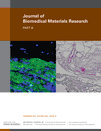Modeling of drug release from biodegradable triple-layered microparticles†
How to cite this article: Lee WL, Shi WX, Low ZY, Li S, Loo SCJ. 2012. Modeling of drug release from biodegradable triple-layered microparticles. J Biomed Mater Res Part A 2012:100A:3353–3362.
Abstract
Numerous models that predict drug release from nonerodible reservoir-membrane sphere systems have been presented. Most of these models cater only to a phase of drug release from a constant reservoir. All these models, however, are not applicable to drug release from biodegradable triple-layered microparticle system, in which the drug-loaded core (reservoir) is surrounded by nondrug holding outer layers (membrane). In this article, a mathematical model was developed for ibuprofen release from degradable triple-layered microparticles made of poly(D,L-lactide-co-glycolide, 50:50) (PLGA), poly(L-lactide) (PLLA), and poly(ethylene-co-vinyl acetate, 40 wt % vinyl acetate) (EVA), where ibuprofen was localized within the nonconstant reservoir (EVA core). The model postulated that the drug release through the bulk-degrading PLLA and PLGA layers consisted of two mechanisms: simple diffusional release followed by a degradation-controlled release through a rate-limiting membrane. The proposed model showed very good match with the experimental data of release from microparticles of various layer thicknesses and particle sizes. The underlying drug release mechanisms are dictated by three parameters determined by the model, including constant characteristic of diffusion, end time point of simple diffusion-controlled release and partition coefficient of drug. The presented model is effective for understanding the drug release mechanisms and for the design of this type of dosage form. © 2012 Wiley Periodicals, Inc. J Biomed Mater Res Part A: 100A:3353–3362, 2012.




